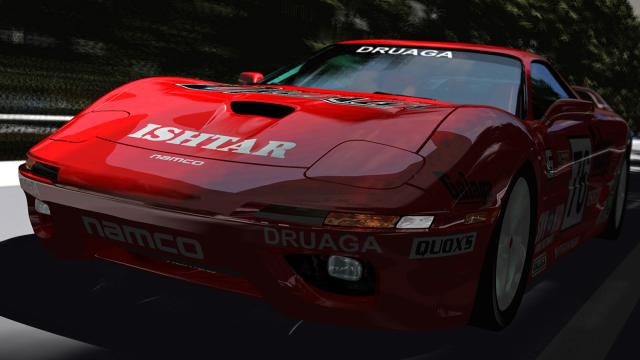Most modern racing games consist of facsimiles real cars used under licensing agreements from the automakers. The reason is easy to grasp: If you’re playing a racing game in the first place, you probably have at least a passing interest in automobiles, and a car you actually recognise or like could deepen your attachment to the experience.
This wasn’t always the way. In the years before licensing arrangements were common in games, developers designed their own cars. Sometimes, the results were shameless copies, skirting legal action by avoiding names and logos. Many of these interpretations were very well done, given the limited technology of the day, though not all were.
The most ambitious designers, though, constructed original cars that drew cues from familiar vehicles, but repurposed them into a unique whole. These are some of the most memorable cars of my childhood, but these days, they’re somewhat lost to time as game makers favour the real stuff. That ends here: Today, we’re giving some of these fictional beauties their due.
Rivelta Mercurio (Ridge Racer V)
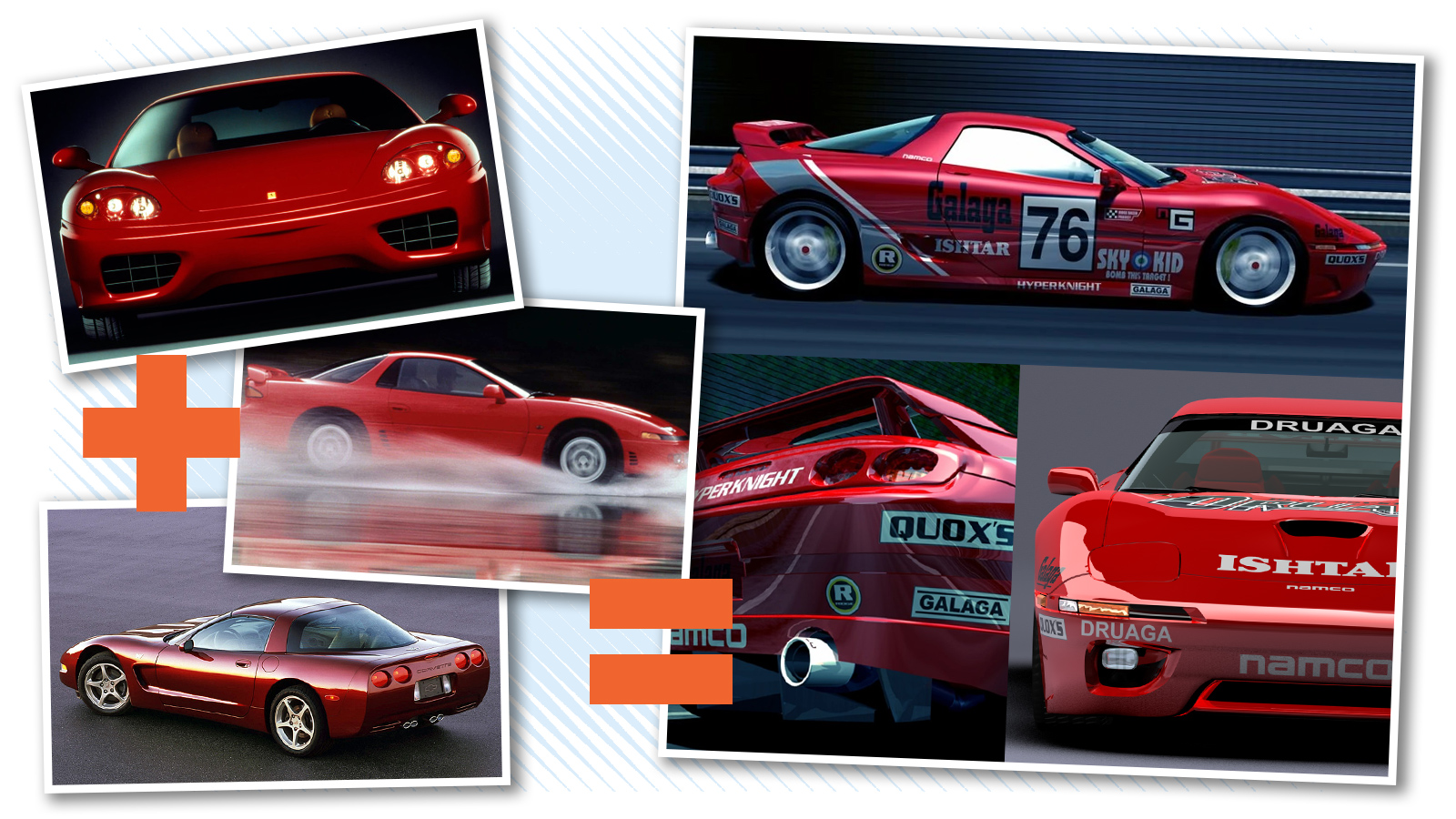
The Rivelta Mercurio can be seen on the cover of Ridge Racer V, one of the PlayStation 2’s most prominent launch titles, not to mention a damn good Ridge Racer. The fifth entry in Namco’s series has aged tremendously well and is worth revisiting today for its sublime handling, killer soundtrack, crisp graphics and of course, those lovely fake cars.
To my eye, the Mercurio primary pulls elements from three sports cars: the Mitsubishi GTO/3000GT, the Ferrari 360 and the C5 Corvette. The sloping front end and dual air intakes evoke the 360, while the pop-up headlights and Coke-bottle proportions call to mind both the GTO and the Corvette. I pick up a C5 vibe from the side as well, though the Mercurio’s hood is much shorter, owing to its midengine layout. The four oval taillights are obviously familiar and — you know what, the more I look at it, the more I see FD RX-7. There’s a lot going on here.
Some of these comparisons are even more fitting when you consider that the Mercurio was envisioned with a 3.0-litre DOHC V6 producing about 400 horsepower in stock trim. That level of output would have seated it comfortably within the 360/Corvette Z06 class.
This Cyberpunk 330 P3/P4 Thing (Rad Mobile)
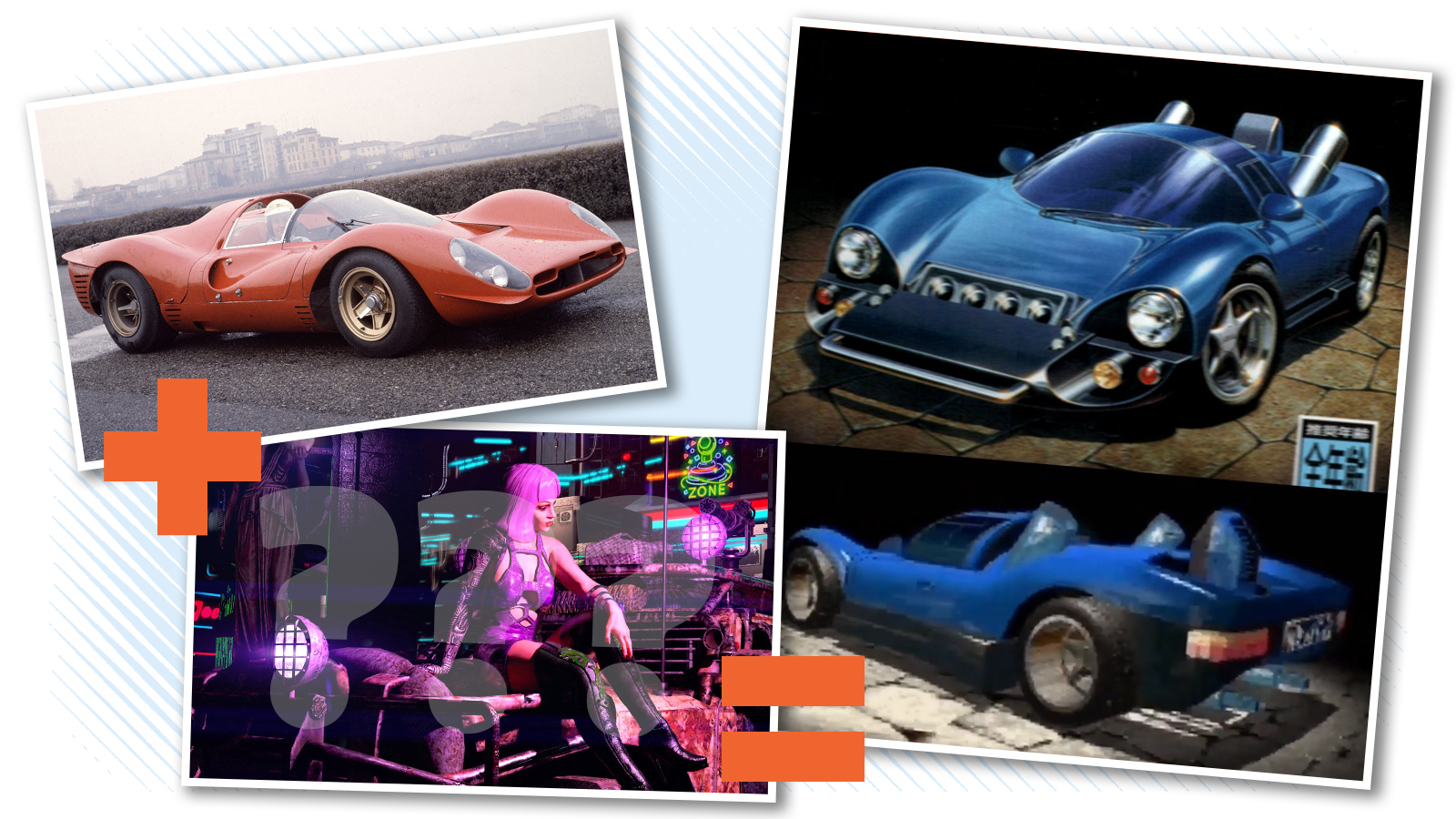
You don’t get to see much of the car you’re driving in Sega’s 1991 Cannonball Run-style arcade racer Rad Mobile because all gameplay is viewed from within the cockpit. You do get to see Sonic as a toy dangling from the windshield, though, months before the critter would get a game of his own.
Thankfully, by cobbling together some other media, we can gather an idea of the Rad Mobile’s design (assuming that is, in fact, the name of the car). In 1994, Sega brought the game home to its doomed Saturn console as Gale Racer, and in Gale Racer, we see gratuitous computer-generated animations of the very vehicle in question, which I can describe only as a Ferrari 330 P3 or P4 missing all sorts of bodywork that’s been replaced with metal armour, a bull bar and comically large exhaust pipes. This car has seen things, man.

From the back though, it’s like a totally different car. There, all traces of Ferrari prototypes have been scrubbed entirely for generic rectangular taillights that are decidedly more ’90s. And indeed, if you pay close attention when you’re buzzing by rival cars in the arcade version of the game, you’ll notice that some look like unmodified 330 P race cars. I have to say I dig this alternate timeline where exotic and exceedingly rare Le Mans legends are widely produced and freely available for customers to mess with, Mad Max style.
Assoluto Fatalita (Rage Racer)
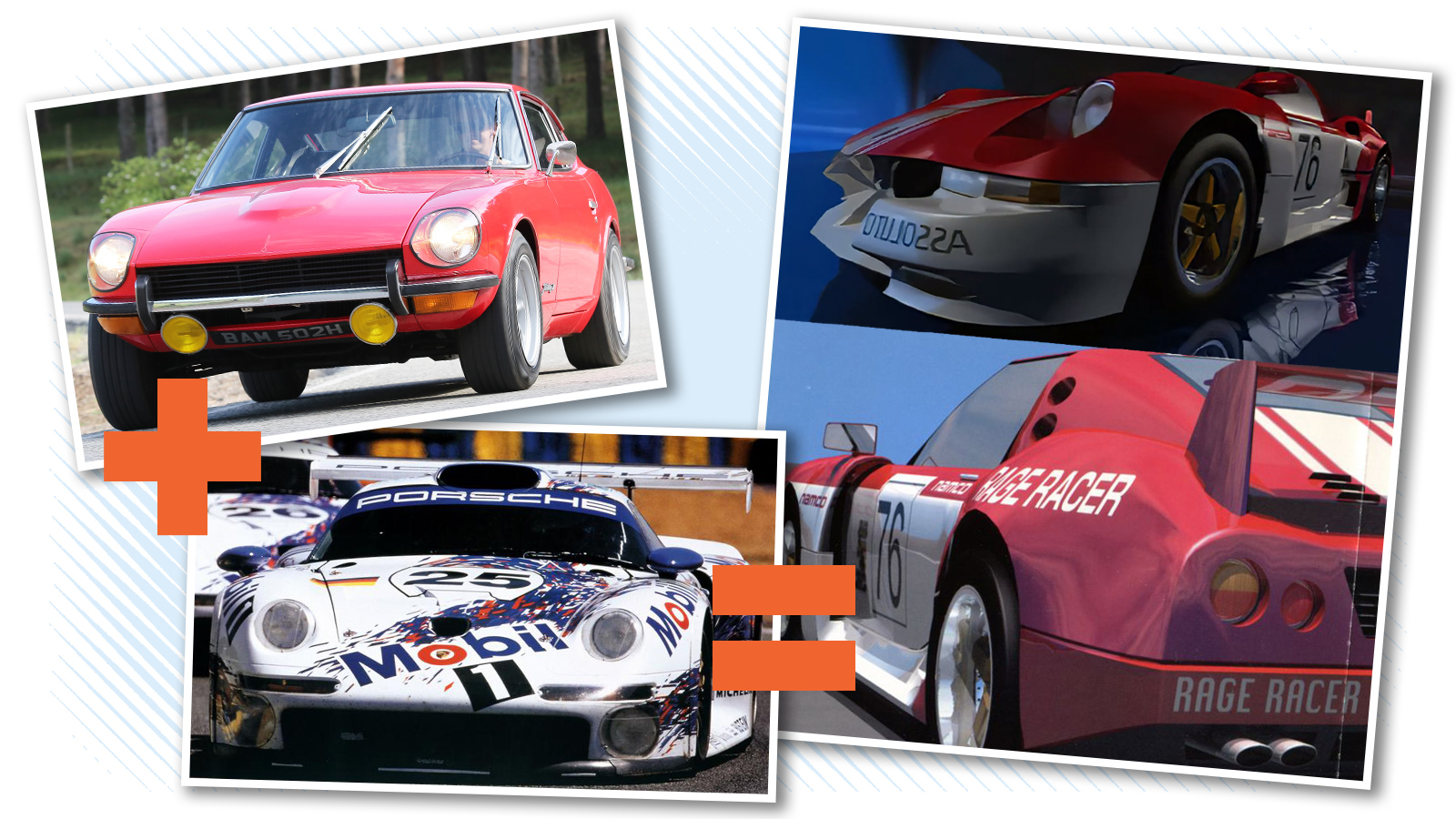
Rage Racer’s Assoluto Fatalita might be the most difficult car in this list to parse out in terms of influence. As far as I’m aware, there’s nothing that’s ever been made that looks exactly like it. In some respects it resembles a Porsche 911 GT1 from certain angles, though the 911 GT1 never had headlights that recessed, nor did it share the Fatalita’s gaping maw. I’ve been playing Rage Racer almost my entire life, and I’ve never been able to put my finger on it.
Thankfully, my colleagues Raph and José are evidently much better at this than I am, and they pegged it. The Fatalita is probably closest to an S130 Datsun Z, more specifically one Bob Sharp raced in an SCCA National Championship. And while the Fatalita is a little more modern and carries a more aggressive aero package, it’s not hard to envision the 280ZX could’ve eventually evolved to this point in racing trim by the time Rage Racer released in 1996. The Fatalita was redesigned in later Ridge Racer installments, where it lost some of its personality and was reduced to a rather uninspired Lamborghini Murciélago clone.
Jansen P12 88 Special (Burnout Paradise)

Burnout Paradise’s Jansen P12 is a Lamborghini Countach. Lose the pop-up headlights, keep the wedge profile and reform the taillight clusters into shapes that fill out the sculpted rear quarters. Then you have a legally distinct-enough love letter to one of the ’80s most recognisable supercars.
But then, right when we thought we’d seen everything, developer Criterion Games issued an update months after the game’s release that brought the Jansen P12 88 Special to Paradise City. The P12 88 Special basically answers the question of what the Back To The Future time machine would have looked like if Doc Brown had chosen a Lamborghini instead of a DeLorean. The car’s stainless-steel bodywork (though you could paint it other colours), numerous vents and hover mode complete with retractable tires completed the tribute.
Lampadati Pigalle (Grand Theft Auto V)
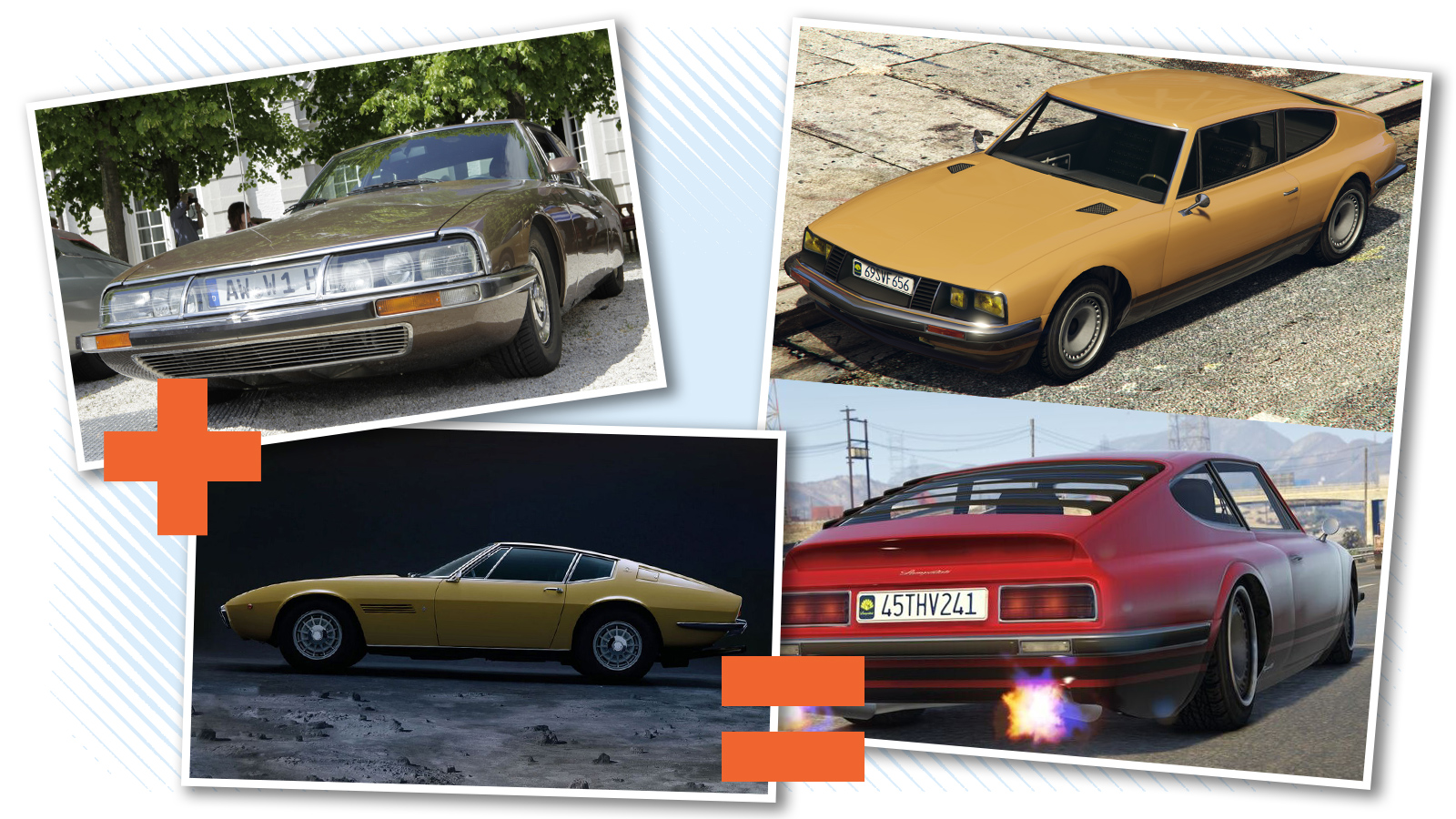
Grand Theft Auto V has so many cars at this point, I could have filled this list with them many times over before discussing any other games. Personally, I find Rockstar’s car design hit and miss, which isn’t terribly surprising considering GTA’s guiding principle is parody, not beauty. Still, every now and then, I see the designers’ enthusiast roots truly shine through, and the results are impressive.
One of my favourites is the Lampadati Pigalle, which looks like a Citroën SM that’s had its edges and oddities sanded down with time. Ironically, the SM is more daring than Rockstar’s imagination here: The Citroën’s angular side windows, rear fender skirts and busy rear-end furniture are all missing in the Pigalle, though the Kammback shape and wraparound headlight cluster/licence plate cover are left mostly untouched. From behind, the Pigalle’s simpler form seems like more of a homage to the original Maserati Ghibli.
Group B Mitsubishi Pajero (Racing Lagoon)

Racing Lagoon is one of those games most people probably don’t know exists, but those who do never shut up about. There’s a good reason for that: This was a Japan-only racing RPG developed by Square, at the peak of Square’s 32-bit heyday. It wouldn’t be the last Square-developed racing game, though I wish it had been because Driving Emotion Type-S didn’t really do the company’s legacy any favours.
Anyway, Racing Lagoon told a street-racing story you’d have to be able to read Japanese to understand, and so I don’t. All of its cars are unlicensed-yet-accurate clones of real ones, though any sense of authenticity goes out the window when you apply some of the game’s more creative exterior modifications.
You can basically make a Le Mans prototype out of every car in Racing Lagoon, and I really do mean every car, from the Volkswagen Beetle to the Toyota Chaser. Not all of the Frankenstein transformations work, but the very fact you can, say, give a Fuso box truck ground effects, is exciting.
My personal favourite is the game’s race-modified Mitsubishi Pajero Evolution, which sort of looks more like a Toyota 222D or some other midengine Group B terror than an endurance sports car or an SUV. If you’d like to see all of Racing Lagoon’s weird and wonderful creations, I highly recommend this video from YouTuber RacerXNFS.
There’s certainly more where this came from, and perhaps one day we’ll return and highlight another handful of fictional cars with interesting real-life roots. Until then, why not give a shout to some of your favourites in the comments?
